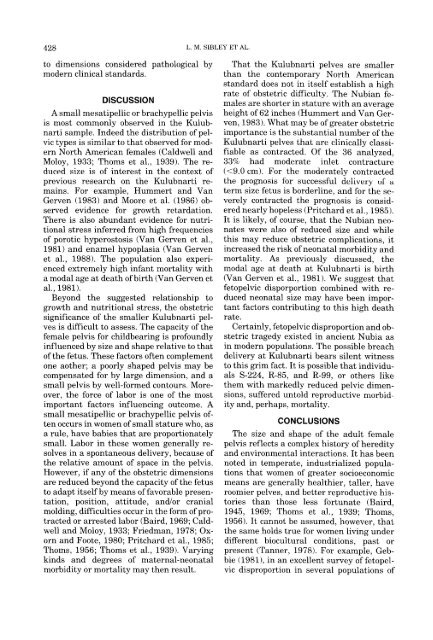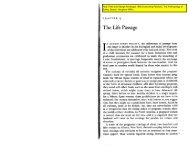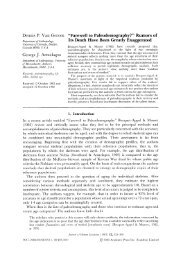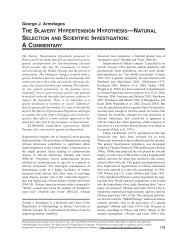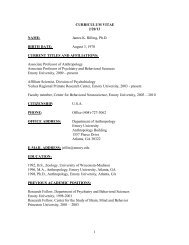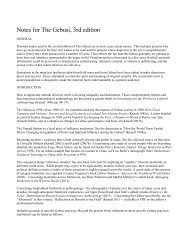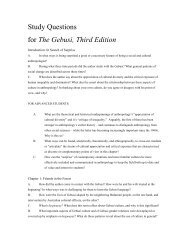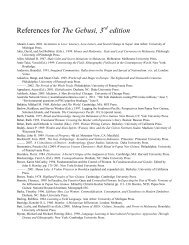Obstetric dimensions of the true pelvis in a Medieval ... - Anthropology
Obstetric dimensions of the true pelvis in a Medieval ... - Anthropology
Obstetric dimensions of the true pelvis in a Medieval ... - Anthropology
Create successful ePaper yourself
Turn your PDF publications into a flip-book with our unique Google optimized e-Paper software.
428<br />
to <strong>dimensions</strong> considered pathological by<br />
modern cl<strong>in</strong>ical standards.<br />
DISCUSSION<br />
A small mesatipellic or brachypellic <strong>pelvis</strong><br />
is most commonly observed <strong>in</strong> <strong>the</strong> Kulub-<br />
narti sample. Indeed <strong>the</strong> distribution <strong>of</strong> pel-<br />
vic types is similar to that observed for mod-<br />
ern North American females (Caldwell and<br />
Moloy, 1933; Thoms et al., 1939). The re-<br />
duced size is <strong>of</strong> <strong>in</strong>terest <strong>in</strong> <strong>the</strong> context <strong>of</strong><br />
previous research on <strong>the</strong> Kulubnarti re-<br />
ma<strong>in</strong>s. For example, Hummert and Van<br />
Gerven (1983) and Moore et al. (1986) ob-<br />
served evidence for growth retardation.<br />
There is also abundant evidence for nutri-<br />
tional stress <strong>in</strong>ferred from high frequencies<br />
<strong>of</strong> porotic hyperostosis (Van Gerven et al.,<br />
1981) and enamel hypoplasia (Van Gerven<br />
et al., 1988). The population also experi-<br />
enced extremely high <strong>in</strong>fant mortality with<br />
a modal age at death <strong>of</strong> birth (Van Gerven et<br />
al., 1981).<br />
Beyond <strong>the</strong> suggested relationship to<br />
growth and nutritional stress, <strong>the</strong> obstetric<br />
significance <strong>of</strong> <strong>the</strong> smaller Kulubnarti pel-<br />
ves is difficult to assess. The capacity <strong>of</strong> <strong>the</strong><br />
female <strong>pelvis</strong> for childbear<strong>in</strong>g is pr<strong>of</strong>oundly<br />
<strong>in</strong>fluenced by size and shape relative to that<br />
<strong>of</strong> <strong>the</strong> fetus. These factors <strong>of</strong>ten complement<br />
one ao<strong>the</strong>r; a poorly shaped <strong>pelvis</strong> may be<br />
compensated for by large dimension. and a<br />
small <strong>pelvis</strong> by well-formed contours, More-<br />
over, <strong>the</strong> force <strong>of</strong> labor is one <strong>of</strong> <strong>the</strong> most<br />
important factors <strong>in</strong>fluenc<strong>in</strong>g outcome. A<br />
small mesatipellic or brachypellic <strong>pelvis</strong> <strong>of</strong>-<br />
ten occurs <strong>in</strong> women <strong>of</strong> small stature who, as<br />
a rule, have babies that are proportionately<br />
small. Labor <strong>in</strong> <strong>the</strong>se women generally re-<br />
solves <strong>in</strong> a spontaneous delivery, because <strong>of</strong><br />
<strong>the</strong> relative amount <strong>of</strong> space <strong>in</strong> <strong>the</strong> <strong>pelvis</strong>.<br />
However, if any <strong>of</strong> <strong>the</strong> obstetric <strong>dimensions</strong><br />
are reduced beyond <strong>the</strong> capacity <strong>of</strong> <strong>the</strong> fetus<br />
to adapt itself by means <strong>of</strong> favorable presen-<br />
tation, position, attitude, andor cranial<br />
mold<strong>in</strong>g, difficulties occur <strong>in</strong> <strong>the</strong> form <strong>of</strong> pro-<br />
tracted or arrested labor (Baird, 1969; Cald-<br />
well and Moloy, 1933; Friedman, 1978; Ox-<br />
orn and Foote, 1980; Pritchard et al., 1985;<br />
Thoms, 1956; Thoms et al., 1939). Vary<strong>in</strong>g<br />
k<strong>in</strong>ds and degrees <strong>of</strong> maternal-neonatal<br />
morbidity or mortality may <strong>the</strong>n result.<br />
L. M. SIBLEY ET AL.<br />
That <strong>the</strong> Kulubnarti pelves are smaller<br />
than <strong>the</strong> contemporary North American<br />
standard does not <strong>in</strong> itself establish a high<br />
rate <strong>of</strong> obstetric difficulty. The Nubian females<br />
are shorter <strong>in</strong> stature with an average<br />
height <strong>of</strong> 62 <strong>in</strong>ches (Hummert and Van Gerven,<br />
1983). What may be <strong>of</strong> greater obstetric<br />
importance is <strong>the</strong> substantial number <strong>of</strong> <strong>the</strong><br />
Kulubnarti pelves that are cl<strong>in</strong>ically classifiable<br />
as contracted. Of <strong>the</strong> 36 analyzed,<br />
33% had moderate <strong>in</strong>let contracture<br />
(~9.0 cm). For <strong>the</strong> moderately contracted<br />
<strong>the</strong> prognosis for successful deliveiy ul<br />
term size fetus is borderl<strong>in</strong>e, and for <strong>the</strong> severely<br />
contracted <strong>the</strong> prognosis is considered<br />
nearly hopeless (Pritchard et al., 1985).<br />
It is likely, <strong>of</strong> course, that <strong>the</strong> Nubian neonates<br />
were also <strong>of</strong> reduced size and while<br />
this may reduce obstetric complications, it<br />
<strong>in</strong>creased <strong>the</strong> risk <strong>of</strong> neonatal morbidity and<br />
mortality. As previously discussed, <strong>the</strong><br />
modal age at death at Kulubnarti is birth<br />
(Van Gerven et al., 1981). We suggest that<br />
fetopelvic disporportion comb<strong>in</strong>ed with reduced<br />
neonatal size may have been important<br />
factors contribut<strong>in</strong>g to this high death<br />
rate.<br />
Certa<strong>in</strong>ly, fetopelvic disproportion and obstetric<br />
tragedy existed <strong>in</strong> ancient Nubia as<br />
<strong>in</strong> modern populations. The possible breach<br />
delivery at Kulubnarti bears silent witness<br />
to this grim fact. It is possible that <strong>in</strong>dividuals<br />
S-224, R-85, and R-99, or o<strong>the</strong>rs like<br />
<strong>the</strong>m with markedly reduced pelvic <strong>dimensions</strong>,<br />
suffered untold reproductive morbidity<br />
and, perhaps, mortality.<br />
CONCLUSIONS<br />
The size and shape <strong>of</strong> <strong>the</strong> adult female<br />
<strong>pelvis</strong> reflects a complex history <strong>of</strong> heredity<br />
and environmental <strong>in</strong>teractions. It has been<br />
noted <strong>in</strong> temperate, <strong>in</strong>dustrialized popula-<br />
tions that women <strong>of</strong> greater socioeconomic<br />
means are generally healthier, taller, have<br />
roomier pelves, and better reproductive his-<br />
tories than those less fortunate (Baird,<br />
1945, 1969; Thoms et al., 1939; Thoms,<br />
1956). It cannot be assumed, however, that<br />
<strong>the</strong> same holds <strong>true</strong> for women liv<strong>in</strong>g under<br />
different biocultural conditions, past or<br />
present (Tanner, 1978). For example, Geb-<br />
bie (19811, <strong>in</strong> an excellent survey <strong>of</strong> fetopel-<br />
vic disproportion <strong>in</strong> several populations <strong>of</strong>


